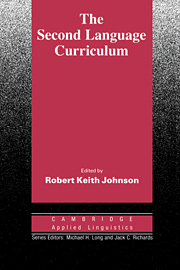Book contents
- Frontmatter
- Contents
- Contributors
- Series editors' preface
- Acknowledgements
- Overview
- I 1 CURRICULUM OVERVIEW
- I 2 CURRICULUM PLANNING
- II ENDS/MEANS SPECIFICATION
- III PROGRAMME IMPLEMENTATION
- IV CLASSROOM IMPLEMENTATION
- Chapter 11 Hidden agendas: the role of the learner in programme implementation
- Chapter 12 The evaluation cycle for language learning tasks
- Chapter 13 Seeing the wood AND the trees: some thoughts on language teaching analysis
- V EVALUATION
- Bibliography
- Index
Chapter 13 - Seeing the wood AND the trees: some thoughts on language teaching analysis
Published online by Cambridge University Press: 05 October 2012
- Frontmatter
- Contents
- Contributors
- Series editors' preface
- Acknowledgements
- Overview
- I 1 CURRICULUM OVERVIEW
- I 2 CURRICULUM PLANNING
- II ENDS/MEANS SPECIFICATION
- III PROGRAMME IMPLEMENTATION
- IV CLASSROOM IMPLEMENTATION
- Chapter 11 Hidden agendas: the role of the learner in programme implementation
- Chapter 12 The evaluation cycle for language learning tasks
- Chapter 13 Seeing the wood AND the trees: some thoughts on language teaching analysis
- V EVALUATION
- Bibliography
- Index
Summary
Introduction
In the development of research on language teaching there has for some years been a tendency to examine more closely ‘what goes on in the classroom’ and to study classroom discourse (turn taking, error correction, and the like; see, for example, Larsen-Freeman, 1980). This interest in the classroom has a very positive side and must therefore be welcomed, because it is close to the reality of language teaching practice. But there is also a negative side which classroom researchers soon recognise: an over-concern with minutiae of teaching and learning, the collection of infinite and unmanageable details, quickly leads to the inability to see the wood for the trees. The contention of this paper is that in order to make sense of classroom discourse and classroom observations they must be placed into a broader context which one might call language teaching analysis. In my remarks I would like to outline the main features of such an analysis.
Before doing so we should consider briefly, by way of introduction, why there has been this tendency to become bogged down in the details of classroom observations and classroom discourse. The interest in the classroom as an empirical database has resulted from developments in pedagogy and linguistics.
In pedagogy the disappointment with research on global ‘methods’, such as comparisons between audiolingualism and cognitivism, had led to a shift of interest from research on teaching to research on learning.
- Type
- Chapter
- Information
- The Second Language Curriculum , pp. 207 - 221Publisher: Cambridge University PressPrint publication year: 1989
- 2
- Cited by



